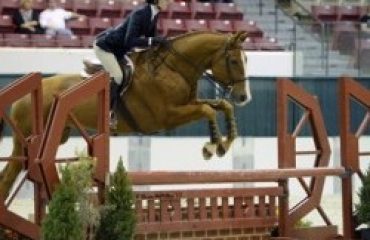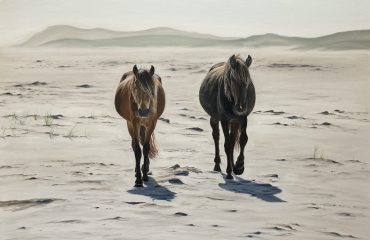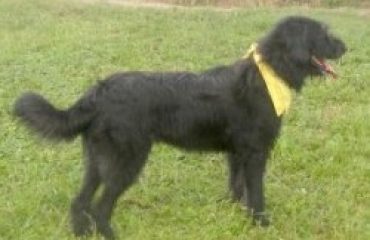
By Britney Grover
Ivanel “Julie” Johnson has always managed to juggle multiple careers, as an eventing coach and competitor, high school teacher and author. She’s also always managed an increasingly debilitating medical condition. Despite her spondylolisthesis, or spinal displacement, Julie has been involved in able-bodied, para and therapeutic riding for over 50 years.
In the last few years, Julie’s disability has advanced to the point that she is not currently able to ride—although if a 10th surgery could alleviate pain throughout her body, she would take a chance on it and hope to find a therapeutic riding stable where she could safely get back in the saddle. In the meantime, she gets her “horse” time vicariously through her writing—under the name J. Ivanel after her grandmother, who inspired her to write.
Julie lives with her husband and mother on a small farm in the Appalachian range of Northwestern New Brunswick, Canada. The milking goats, egg-laying chickens, work/riding horse and “obligatory” cats and dogs may be gone, but the inspiring mountain views remain.
How long have you been part of the horse world and what’s your involvement now?
I’ve been riding since the age of 7 and owned my first (run-away scamp!) pony at age 10. I’ve owned event horses and school horses in the 50 years since until just the last few years. While my first pony taught me a lot, he also worsened my spinal condition by weekly dumping me in a hard-hitting heap. I was diagnosed with spondylolisthesis in my lower back at age 14, when I also started volunteering with Special Ability Riding Institute in London, Ontario. That opened doors for me in both the world of therapeutic riding as well as able-bodied riding and competing; I became a certified coach in both.
While my regular days of riding and instructing are necessarily over due to chronic pain and mobility/travel issues, I am still occasionally invited to coach at clinics, judge shows, write articles for various equestrian federations, etc. I also work online on various platforms to raise awareness for therapeutic riding programs worldwide, as well as the Equine Assisted Growth and Learning Association (EAGALA) and even the Paralympics.
 What’s your biggest achievement in the horse world?
What’s your biggest achievement in the horse world?
I rescued a dun Percheron cross from a dealer’s yard and, after a year of retraining, he took me to the provincial championships of eventing twice and at levels far beyond where I ever expected to be riding. He was just so safe and trustworthy, on top of being very bold—and like in therapeutic riding itself, his extra-broad back and girth made him a comfortable mount for me in all his gaits.
As far as certifications in the equine industry, after years of combined study and examinations, I received an instructor rating from Cheff Therapeutic Riding Center via what was then called the North American Riding for the Handicapped Association (NARHA), an instructor rating from what was then called the Canadian Equestrian Federation, an assistant instructor rating from the British Horse Society and a practitioner rating with EAGALA.
What did you do before becoming a writer?
I have always written, on top of being a high school English/drama teacher in three different countries and coaching and competing at eventing. For nearly a decade, I owned a riding stable from whence a therapeutic riding program was also running and we had 60 adults and young people competing at hunter/jumper/dressage shows and horse trials. Then we sold the stable and I began freelancing and moving around in the U.S., UK and Canada a lot more, teaching both able-bodied and para riders at clinics and horse trials—and on a 20,000-acre estate in the Scottish Highlands where I lived.
 Tell us about your books.
Tell us about your books.
I’ve always loved wordplay, which leads well to imagining ‘clues’ in mysteries. In the equestrian world especially, there are so many double entendres. A “cozy” (a genre of mystery in which there is little blood/gore or violence) short story I wrote called “Winter’s Warmblood” features many of these. For instance, a “coffin” is a bone in the hoof, but also a standard cross-country jump for competitive three-day event riders. Then there’s “ ‘throatlatch,” “stifle,” “cannon,” “wither” and even “warmblood” itself, all lending to the inspiration for stable-set murders.
My novels are murder-mystery whodunnits and the most recent one in the JUST (e)STATE series is called “Just a Stale Mate.” It has won several awards in the last year, including being honored as the Maxy Award’s Mystery and Crime Runner-Up for 2023. This one is set in 1969, which was also an important year for Riding for the Disabled starting in the UK and for Cheff Centre/NARHA starting in the USA. I’ve amalgamated the two original female driving forces of the American and Canadian associations, Lida McGowan and Lelia Sponsel, into one woman in the book, and another more humorous character from Yorkshire is a rider at the Ontario retreat and rehab center; she and her horse inadvertently stumble over a number of clues, in somewhat comedic circumstances.
How did writing your books impact your life?
While I’ve always written and had some works published and produced on stage since I was a teenager, having the larger manuscripts get picked up starting in 2022 has helped me come to terms with my progressive disabilities and arthritis, both of which can often have me bedridden. After so loving the outdoors, living abroad and traveling, and loving to gallop and jump, and hike or ride long distances, it’s been a shock to my emotional state to be barely able to make it into a local town via a car anymore! So it’s a matter of making lemonade out of the lemons life squishes on you. Thanks to laptops and notebooks, it’s easy to write from a reclining position, and inventing new places or characters, or writing about all the places and people I’ve met in my life, is a way of feeling that I’m still doing all of that. Plus, I still have those views and can pretend I’m exploring fields and forests across or down in the valley!
 What’s your favorite thing about being a writer?
What’s your favorite thing about being a writer?
Writing is a wonderful way to express emotions or to educate, as well as allowing for the many creative inventions that beg to emerge. I love blending several eccentricities of various people I’ve known into one character in my stories or plays, and I enjoy tantalizing readers with brief descriptions of both exterior and interior settings that I’ve seen or experienced. Plus, as my grandmother used to do when babysitting us, I love designing clues, puzzles and treasure hunts for the readers of my whodunnits.
What is the best thing about your life?
Having a helpful husband and mother who do a lot of errands for me that I can’t manage, being a virtual part of several writing groups, some entertaining pets who have specific times of the evening set aside for playtime (and they tell you if you’re late for it!) and, again, that amazing view across the Appalachians that inspires me every day, no matter what the weather or the season.
What’s the best-kept secret about what you do?
I reveal a number of secrets about my connection with royalty and celebrities in a new manuscript for which I’m trying to find just the right publisher. It’s horse-themed, but the equine-related facts are also all symbolic of my life. Thus, it’s a creative-narrative ‘memoir’ called “Green Broke,” which is a metaphoric title in itself. Two chapters from “Green Broke” were rewritten as the short story “Iron Bone” published in 2019’s precedent-setting anthology “Nothing Without Us,” which became part of the disabilities studies syllabus at Trent University and earned a 2020 Prix Aurora Award nomination.
In it I reveal, with considerable self-deprecating humor, some mistakes I’ve made while working for a disabled baroness in England, sleeping in a cow pasture on Princess Anne’s estate and how, a different time, her ex-husband, Captain Mark Phillips, stole my breakfast. Other secrets revealed in the book are how I met famous singer/songwriter Ian Thomas at a manure pile, how I was briefly held in Dan Akroyd’s arms, how a cast member of “The Full Monty” came to me with all his clothes on, and how the Royal Canadian Mounted Police and Scotland Yard had to interview me multiple times regarding a relationship best left forgotten—but of course now being used as fodder for my writing!
For more information, visit linktr.ee/j.ivanel or follow @j.ivanel on Instagram












